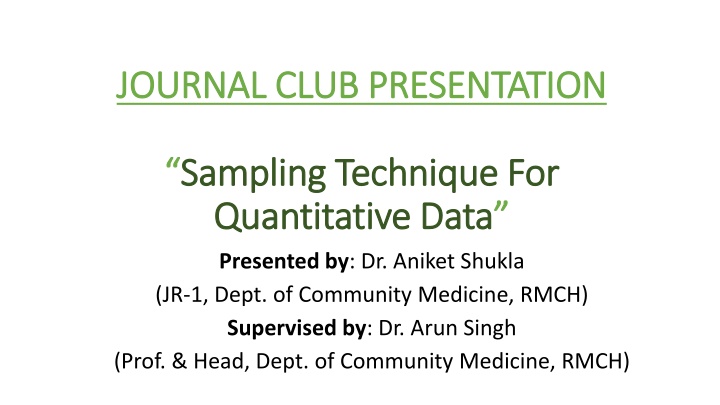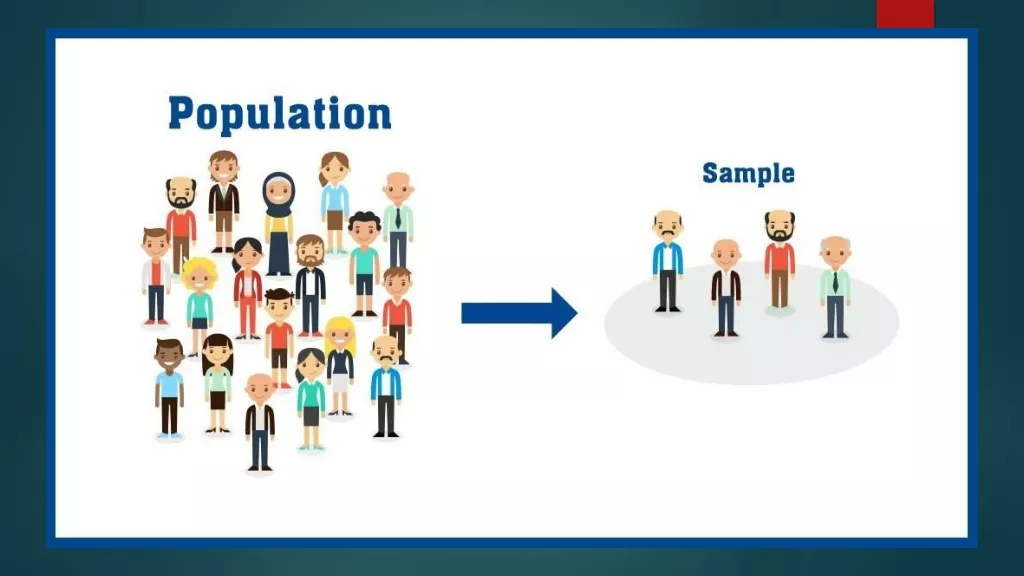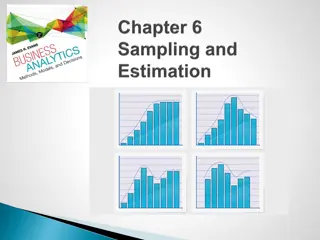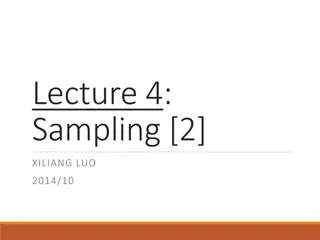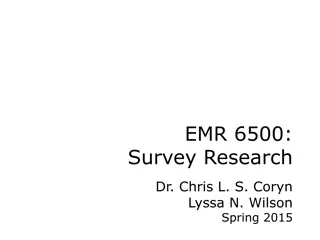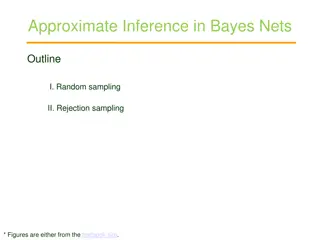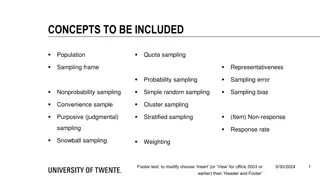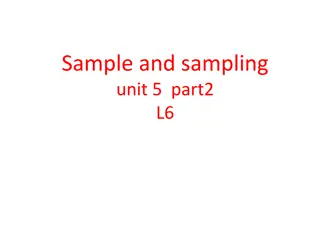Sampling Technique For Quantitative Data Presentation
This presentation focuses on sampling techniques for quantitative data collection in research studies. It covers concepts such as population, sample, sampling frame, types of sampling, and non-probability sampling methods. Dr. Aniket Shukla presents the importance of rigorous sampling plans to avoid bias in study estimates. The discussion enhances understanding of how individuals are selected from sample frames ensuring representativeness and the reliability of study outcomes.
Download Presentation

Please find below an Image/Link to download the presentation.
The content on the website is provided AS IS for your information and personal use only. It may not be sold, licensed, or shared on other websites without obtaining consent from the author.If you encounter any issues during the download, it is possible that the publisher has removed the file from their server.
You are allowed to download the files provided on this website for personal or commercial use, subject to the condition that they are used lawfully. All files are the property of their respective owners.
The content on the website is provided AS IS for your information and personal use only. It may not be sold, licensed, or shared on other websites without obtaining consent from the author.
E N D
Presentation Transcript
JOURNAL CLUB PRESENTATION JOURNAL CLUB PRESENTATION Sampling Technique For Sampling Technique For Quantitative Data Quantitative Data Presented by: Dr. Aniket Shukla (JR-1, Dept. of Community Medicine, RMCH) Supervised by: Dr. Arun Singh (Prof. & Head, Dept. of Community Medicine, RMCH)
Article: Sampling: how to select participants in my research study? Author: Jeovany Mart nez-Mesa.1 David Alejandro Gonz lez-Chica.2 ,Renan Rangel Bonamigo .3, Jo o Luiz Bastos.4 Background: In this paper, the basic elements related to the selection of participants for a health research are discussed. Sample representativeness, sample frame, types of sampling are described. Objectives: To introduce readers to issues related to sampling.
Population: This is also known as universe, which means a group of animate or inanimate units of observation about which certain information is required. Sample: A Sample is a portion or part of the population or universe selected in some manner from which data is collected regarding the required information. Sampling Frame: It is a complete, nonoverlapping list of all the sampling units in the population or universe from which the sample is to be drawn. Sampling: Sampling can be defined as the process through which individuals or sampling units are selected from the sample frame. Without a rigorous sampling plan the estimates derived from the study may be biased.
TYPES OF SAMPLING TYPES OF SAMPLING
NON-PROBABILITY SAMPLING There is no idea of population in non-probability sampling There is no probability of selecting any individual It has free distribution The observations of non-probability sample are not used for generalization purpose The different types of non-probabilistic sampling are detailed below:
In this type of sampling, the subject were selected that is easily available & easy to recruit. Research does not consider selecting subjects are representative of the entire population or not. The only aim is to complete the study at easy way. E.g. researcher want to study on stroke patients so he take all type of stroke. Randomized clinical trials are usually based on convenience sampling. After sampling, participants are usually randomly allocated to the intervention or control group (randomization), although randomization is a probabilistic process to obtain two comparable groups (treatment and control), the samples used in these studies are generally not representative of the target population.
In this method, sampling units selected on the basis of personal judgement. Here, instead of random selection, population of interest are choose based on judgement or prior knowledge of thee units for getting good result. E.g. cricket match, so cotch will select good player only for getting good result . This technique was used in the study by Roubille et al, in which recommendations for the treatment of comorbidities in patients with rheumatoid arthritis, psoriasis, and psoriatic arthritis were made based on the opinion of a group of experts.
In this method, the population is divided into different subgroups based on relevant characteristics .Then from subgroups the individual were selected. (according to researcher convenience) It is similar to stratified but the subjects were chosen randomly in stratified but here the subject were chosen non-randomly from subgroups. For example, in the study by Larkin et al., the combination of vemurafenib and cobimetinib versus placebo was tested in patients with locally-advanced melanoma, stage IIIC or IV, with BRAF mutation.7 The study recruited 495 patients from 135 health centers located in several countries. In this type of study, each center has a quota of patients.
In this type of sampling, a few individuals who meet the inclusion criteria were selected. Then asked to that all participants to recruited other participants with the same characteristics. The process is repeated till desired sample size reached. E.g. one facial palsy patient selected then that participants selected other facial palsy patients This is frequently used in studies investigating special populations, for example, those including illicit drugs users, as was the case of the study by Gon alves et al, which assessed 27 users of cocaine and crack in combination with marijuana.
PROBABILITY SAMPLING Refer from the sample as well as the population. Every individual of the population has equal probability to be selected in to the sample. Representative of the population. The observation of the probability sample are used for the inferential purpose.
In this technique, we have a full list of sample units or participants (sample basis), and we randomly select individuals using a table of random numbers. This method is applicable when the population is small, homogenous, and easily available. An example is the study by Pimenta et al, in which the authors obtained a listing from the Health Department of all elderly enrolled in the Family Health Strategy and, by simple random sampling, selected a sample of 449 participants.
Applicable when population is large and homogenous. Samples were selected in a systematic mathematical way Every k unit in the population is selected. First sample interval will be calculated. Sample interval k = total population/ desired sample size ,so first number will be selected by simple random method followed by every k selected from the population. For example, in the study of Kelbore et al, children who were assisted at the Pediatric Dermatology Service were selected to evaluate factors associated with atopic dermatitis, selecting always the second child by consulting order
Applicable when population is large and heterogenous First population is divided into group known as strata e.g. gender, religious, location Now from strata the sample is drawn randomly in proportion to its size. An example is the study conducted in South Australia to investigate factors associated with vitamin D deficiency in preschool children. Using the national census as the sample frame, households were randomly selected in each stratum and all children in the age group of interest identified in the selected houses were investigated.
Applicable when population area is too large. So, the first population is divided into smaller non overlapping units or groups known as clusters, then some of this clusters are randomly selected in the study E.g. geographical area (villages, city, town etc.) In the above-mentioned study, the selection of households is an example of cluster sampling The company has offices in 10 cities across the country (all with roughly the same number of employees in similar roles). You don't have the capacity to travel to every office to collect your data, so you use random sampling to select 3 offices - these are your clusters.
MULTISTAGE SAMPLING: Applicable only in large surveys. As the name implies, sampling procedure carried out in several stages using simple random sampling technique, at each stage any one of the different type of random sampling technique may be used. Eg. In Country survey: Stage 1- Districts choose ,Stage 2- Taluka, Stage 3- village, etc. An example is the study of Duquia et al. to assess the prevalence and factors associated with the use of sunscreen in adults. The sampling process included two stages.Using the 2000 Brazilian demographic census as sampling frame, all 404 census tracts from Pelotas were listed in ascending order of family income. A sample of 120 tracts were systematically selected (first sampling stage) In the second stage, 12 households in each of these census tract (second sampling stage units) were systematically drawn. All adult residents in these households were included in the study (third sampling stage units). All these stages have to be considered in the statistical analysis to provide correct estimates.
CONCLUSION Researchers need to decide during the planning stage of the study if they will work with the entire target population or a sample. Working with a sample involves different steps, including sample size estimation, identification of the sample frame, and selection of the sampling method to be adopted.
